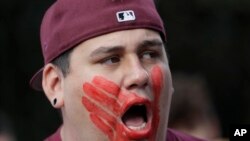Concern is growing that the COVID-19 pandemic may be putting some Native American families at increased risk for violence and sexual assault.
“Our town’s pretty small, and you can hear cops running from one end to the other,” said T.J. Whirlwind Soldier, a member of the Sicangu Oyate, one of seven tribes of the Lakota Nation.
He was speaking about Mission, a small town on the Rosebud Reservation in South Dakota, where the population hovers around 1,200 and where unemployment and poverty rates are high.
“I’m hearing more police sirens these days,” he said. “I think that the coronavirus is really affecting people. You see a lot of people being aggressive, and it’s causing an increase of drinking and drug abuse.”
Whirlwind Soldier works for Sicangu MVP, a community-based program helping young males and their families recover from violence and other trauma.
“Just today, the ambulance service on our reservation contacted our women’s shelter while they were responding to a domestic violence case,” Whirlwind Soldier said. “And that was at only eight o’clock in the morning.”
Sicangu MVP is one arm of the White Buffalo Calf Women’s Society (WBCWS), a nonprofit organization that serves victims of domestic violence and sexual assault and boasts the oldest shelter in Indian Country.
“There are other systems that we work with and deal with,” said WBCWS Director Lindsey Compton. “The Indian Health Service, law enforcement and first responders, even our sexual assault response team for our service area, they’ve all seen increased calls specifically for sexual assault and domestic violence.”
Triggers historic trauma
VOA heard similar reports from other reservations, including Crow Creek, about 180 kilometers northeast of Rosebud.
“You may be talking about two or three families living in a single household,” said Lisa Hope Heth, director of Wiconi Wawokiya (“Helping Families”), a nonprofit in Fort Thompson, South Dakota. “And since they can’t leave the home or go anywhere, there tend to be more opportunities to get into arguments over little things.”
Especially, she added, if there is not enough food to go around. For many Native Americans, the current pandemic and its economic effects recall the anguish of their ancestors, who were forced into confinement on reservations during the 19th century to face starvation and worse.
“I’ve been seeing a lot of Facebook posts about historical trauma,” Heth said. “Even about the way people have to wear a mask now. Sometimes that triggers them. I even have a hard time with it.”
Lockdowns and stay-at-home orders mean many victims of violence have nowhere to turn, she said, “because the offenders are in the homes with them and can keep a close eye on them.”
Heth also worries about reservation youth.
“We’re seeing teenagers going out and drinking because there are no adults out to supervise, no one to report them,” Heth said, and these behaviors could not only encourage the spread of COVID-19 but make youth vulnerable to victimization.
Violence, natural disasters linked
VOA reached out to the StrongHearts Native Helpline, a confidential, culturally appropriate domestic violence helpline for Native Americans across the United States.
“We are seeing a decrease in the number of calls that we usually receive,” said Elizabeth Carr, a member of the Sault Ste. Marie Tribe of Chippewa Indians who serves as StrongHeart’s senior Native affairs advisor. “But the way we are looking at it is that our victims and survivors probably don’t have the opportunity to make that call, given that they are socially distancing with their abusive partners.”
At the same time, Carr said she has seen an increase in visits to StrongHeart’s website and social media pages, which may represent only the tip of the iceberg, as many Native Americans lack internet access.
“It’s hard to say what will happen in the future when social distancing ends. Evidence from previous situations like hurricanes indicates we can anticipate seeing a larger number of folks calling in when they have some safe time and safe space to make those calls,” she said.
Researchers have noted the prevalence of intimate partner violence, child and elder abuse and sexual violence in the wake of natural disasters. A study of couples in southern Mississippi in the months before and after Hurricane Katrina in 2005, for example, showed a 35% increase in psychological aggression toward women and a 98% increase in their physical abuse, blaming severe disruptions in home and social environments, shortages of food and other provisions and failures by government bureaucracy and law enforcement.
In a virtual news briefing April 6, U.N. Secretary-General Antonio Guterres noted a sharp rise in domestic violence in the weeks since COVID-19 restrictions were put in place.
“In some countries, the number of women calling support services has doubled,” Guterres said. “Meanwhile, healthcare providers and police are overwhelmed and understaffed. Local support groups are paralyzed or short of funds. Some domestic violence shelters are closed; others are full.”
Guterres called on governments to address the issue as part of their response to the coronavirus pandemic.




